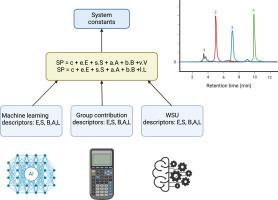评估反相液相色谱和气相色谱中用于模型保留的机器学习和组贡献溶解参数模型描述符
IF 3.2
引用次数: 0
摘要
亚伯拉罕的溶剂化参数模型是模拟反相液相色谱和气相色谱系统的一个有价值的工具。除溶质描述子McGowan的特征体积V外,其余溶质描述子E、S、A、B和L均通过实验确定。估计方法、机器学习和群体贡献方法是估计溶质描述符的实验方法的两种替代方法。在这项工作中,我们评估了使用机器学习和群体贡献方法估计的溶剂化参数模型溶质描述符的适用性。对于本研究中研究的反相液相色谱和气相色谱系统,使用机器学习方法估计的总体溶质描述符比使用群贡献法估计的溶质描述符更适合。对于Luna C18(2)固定相模型所研究的甲醇-水二元溶剂体系,使用机器学习估计描述符时,模型的决定系数在0.982 ~ 0.953之间,而使用群体贡献估计描述符时,模型的决定系数在0.923 ~ 0.943之间。对于所研究的气相色谱模型,当使用机器学习估计描述符时,确定系数范围为0.995至0.987,而使用群体贡献估计描述符时,确定系数范围为0.941至0.977。然而,机器学习和群体贡献描述符都不适合模型以及实验确定的参考WSU描述符。本文章由计算机程序翻译,如有差异,请以英文原文为准。

Assessment of machine learning and group contribution solvation parameter model descriptors for model retention in reversed-phase liquid chromatography and gas chromatography
Abraham's solvation parameter model is a valuable tool for modelling reversed-phase liquid chromatography and gas chromatography systems. Except for the solute descriptor McGowan's characteristic volume, V, the remaining solute descriptors E, S, A, B, and L of the solvation parameter model are experimentally determined. Estimation approaches, machine learning, and group contribution methods are two alternatives to experimental approaches to estimating solute descriptors. In this work we evaluated the applicability of solvation parameter model solute descriptors estimated using machine learning and group contribution methods. Overall solute descriptors estimated using the machine learning approach fit better than solute descriptors estimated using the group contribution method for both reversed-phase liquid chromatography and gas chromatography systems studied in this work. For the studied methanol-water binary solvent system on a Luna C18(2) stationary phase model, coefficient of determination ranged from 0.982 to 0.953 when using machine learning estimated descriptors, whereas with group contribution estimated descriptors, models ranged between 0.923 and 0.943. For the studied gas chromatography models, coefficient of determination ranged from 0.995 to 0.987 when using machine learning estimated descriptors, whereas with group contribution estimated descriptors ranged between 0.941 and 0.977. However, both machine learning and group contribution descriptors did not fit in models as well as experimentally determined reference WSU descriptors.
求助全文
通过发布文献求助,成功后即可免费获取论文全文。
去求助
来源期刊

Journal of chromatography open
Analytical Chemistry
CiteScore
2.50
自引率
0.00%
发文量
0
审稿时长
50 days
 求助内容:
求助内容: 应助结果提醒方式:
应助结果提醒方式:


